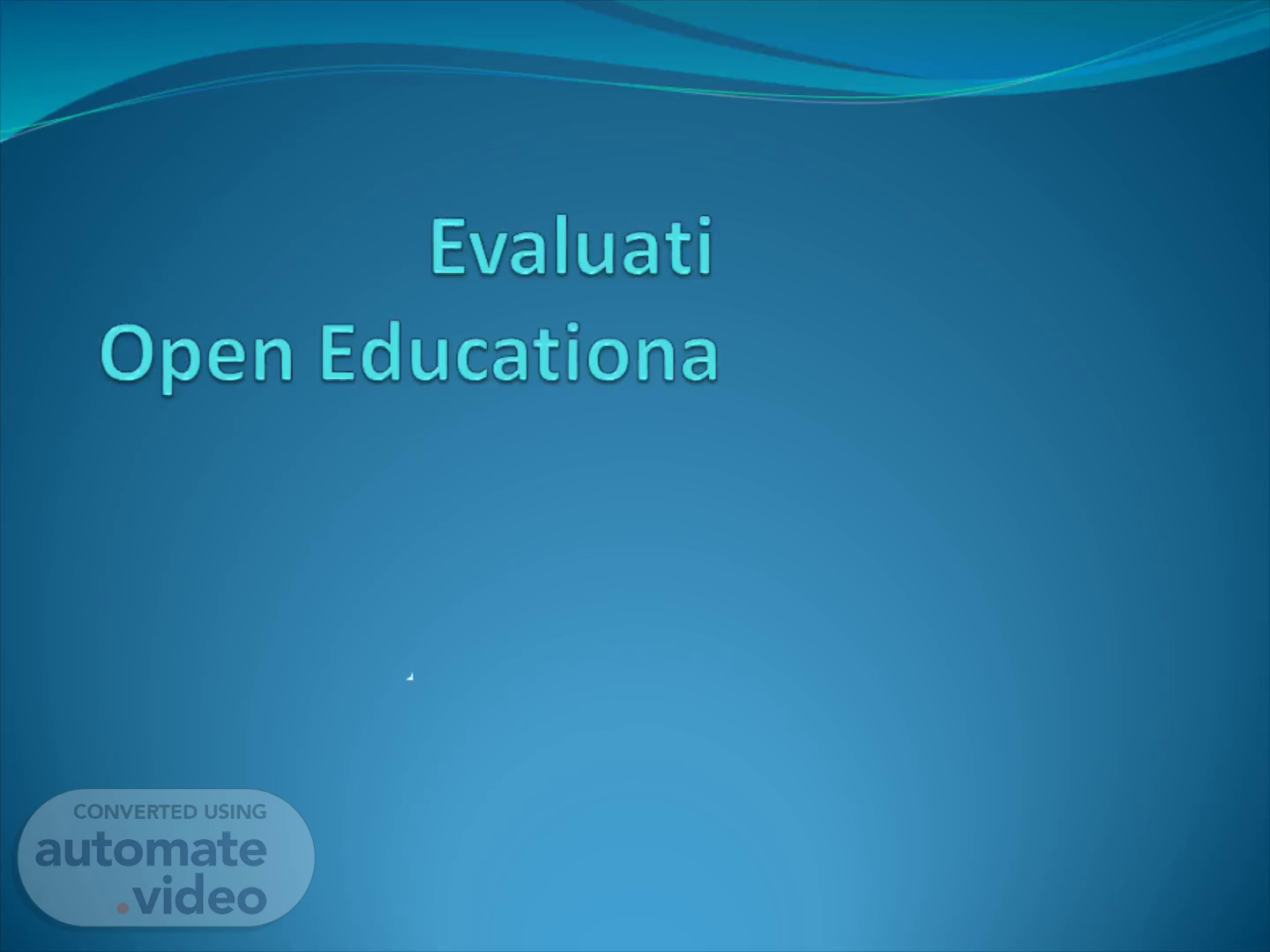
Evaluating Open Educational Resources
Scene 1 (0s)
Evaluating Open Educational Resources. Dr S K Pulist Additional Director IGNOU, New Delhi 9810701723 (M) [email protected].
Scene 2 (9s)
What is OER. Open Educational Resources are material that are licensed to be freely used, edited, and distributed. OER include – textbooks, videos, music, asignments, lab modules, readings, syllabi, entire course and much more..
Scene 3 (23s)
Tips for finding OER. Develop a list of keywords, synonyms, and related subjects First go for broad themes Then come back to specific course goals and learning outcomes.
Scene 4 (35s)
Creator of the Content. Who is the creator of the content and what kind of expertise and experience does he/she has? What is the authenticity of the creator. Is the work his/her own creation or plagiarized? What is the intended purpose of the creator (educate/inform/sell/entertain, change mind/propaganda/create sensation, etc.? Are their logical fallacies, inappropriate appeal, biasness in dealing with the topic, conflict of interest?.
Scene 5 (57s)
Affiliating organisation. What is the affiliating organisation? What kind of reputation does it have in the field? Does the organisation have some control mechanism? How do they assure quality of the content? Has the content uploaded by the organisation peer-reviewed?.
Scene 6 (1m 11s)
Affiliating organisation contd….. Has the content been updated recently? What is the tolerance level of the organisation towards mistakes and errors in the content? Is there any third party sponsor to the organisation? And what is its reputation, agenda and bias? Are there any ratings, comments, or feedback regarding the content? If yes does this help you in selecting the content?.
Scene 7 (1m 30s)
Appropriateness. Is the content presented at a reading level appropriate for higher education students? How is the content useful for instructors or students? Is the content itself appropriate for higher education? Does the resource present over all ideas of the subject appropriately? Does the information directly address one or more of the class objectives? Does the content suit the target audience?.
Scene 8 (1m 47s)
Content Accuracy and Technical Accuracy. Is the content accurate based on both your expert knowledge and feedback from external sources? Are there any factual, grammatical, or typographical errors? Has the material been peer reviewed?.
Scene 9 (2m 0s)
Comprehensibility and Readability. Is the content clear and comprehensible to students? Is the content well-categorized in terms of logic, sequencing, and flow? Are the topics in the resource presented in a logical and clear manner? Is the content consistent with its language and key terms? Is the information clear and understandable? For Multimedia resources, are the audio/video quality high?.
Scene 10 (2m 19s)
Accessibility. Is the content accessible to students with disabilities If you are using Web resources, does each image have alternate text that can be read? Do videos have accurate captioning? Is there a transcript? Are students able to access the materials in a quick, non-restrictive manner? Is the resource available in alternative formats (doc or rtf)? For audio/video resources, Can it be used over a different types of devices and software versions – old and new? Is it available in a format you can modify?.
Scene 11 (2m 41s)
Quality?. Peer Review: OER platforms that offer peer review generally post a detailed explanation of their peer-review process on their website and provide details about their assessment of the materials. User Review: Many OER include user reviews rating the materials on a 5-star spectrum. User reviews generally include the name, occupation, and institution of the reviewer as well as a detailed review following an assessment rubric..
Scene 12 (3m 1s)
Licensing. Identify the type of License attached to the resource/content. Does the license allow for educational reuse of the material? Does the license allow modifications or adaptations of the materials? If so, can you modify the resource to better fit the class objectives or encourage active learning?.
Scene 13 (3m 17s)
Adaptability and Modularity. Is the resource in a file format which allows for adaptations, modifications, rearrangements, and updates? Is the resource easily divided into modules, or sections, which can then be used or rearranged out of their original order? Is the content licensed in a way which allows for adaptations and modifications?.
Scene 14 (3m 34s)
Interface. Is the interface easy to navigate? Is the resource free of significant interface issues, including navigation problems, distortion of images/charts, and other display features? Does the OER contain any supplementary materials, such as homework resources, study guides, tutorials, or assessments? Are there broken links or obsolete formats?.
Scene 15 (3m 51s)
Cultural Relevance. Is the text culturally sensitive and not offensive in any way. Does it use examples that are inclusive of a variety of races, ethnicities, and backgrounds. Can the examples, illustrations, case studies be adapted in Indian or local context? Does the resource promote some specific faith, culture or religion?.
Scene 16 (4m 8s)
Adapting OERs. Check the licensing to confirm if you have permissions to edit the materials. Determine what you need/want to change. Select the technology for editing that you are most comfortable using. Seek training or support as needed. Make sure to attribute the original OER..
Scene 17 (4m 24s)
Adapting OERs contd…. Open the resource in appropriate application for editing/modificaiton Include examples relevant to your institution. Combine relevant chapters from multiple OER to make a single readable material. Delete irrelevant chapters. Create additional chapters. Translate a work into a different language. Once editing is complete, distribute to your students..
Scene 18 (4m 41s)
Sources of OER. Creative Commons databases OER Commons MERLOT Mason OER Metafinder Wikipedia Wikimedia Open Textbook Libraries OpenStax Pressbooks Directories.
Scene 19 (4m 53s)
References. https://opentextbc.ca/adaptopentextbook/wp-content/uploads/sites/144/2016/06/0001.jpg https://ecampusontario.pressbooks.pub/facultyoertoolkit2/chapter/evaluating-oer/ https://library-cuanschutz.libguides.com/ld.php?content_id=49567471 https://www.rcampus.com/rubricshowc.cfm?code=L9WC6X&sp=yes https://guides.library.kumc.edu/oer/finding-oer https://guides.library.kumc.edu/oer/adopting-adapting-oer https://www.youtube.com/watch?v=a17T-vcIdKI&t=329s https://guides.library.kumc.edu/oer/evaluating-oer https://instr.iastate.libguides.com/oer/evaluate.